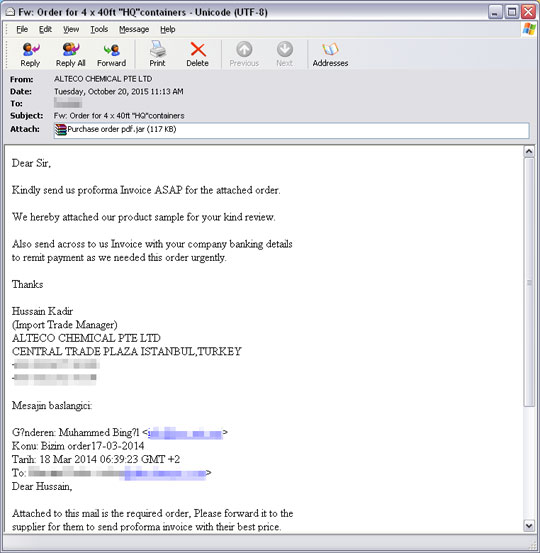JAVA_ADWIND.JEJOOZ
Trojan:Java/Adwind.F (Microsoft); Troj/Java-AAW (Sophos); Trojan.Java.Adwind (Ikarus); Java/Adwind.MF trojan (ESET-NOD32); Trojan.Maljava (Symantec); Backdoor:Java/Adwind.E (F-Secure)
Windows


Threat Type: Backdoor
Destructiveness: No
Encrypted: Yes
In the wild: Yes
OVERVIEW
This backdoor arrives as an attachment to email messages spammed by other malware/grayware or malicious users.
It does not have any propagation routine.
It executes commands from a remote malicious user, effectively compromising the affected system. It connects to a website to send and receive information.
It gathers information and reports it to its servers.
TECHNICAL DETAILS
Arrival Details
This backdoor arrives as an attachment to the following email messages spammed by other malware/grayware or malicious users:
Installation
This backdoor drops the following copies of itself into the affected system and executes them:
- %User Profile%\9g4hLVBxmxF\igY81hgTEp2.fOLA45
(Note: %User Profile% is the current user's profile folder, which is usually C:\Documents and Settings\{user name} on Windows 2000, XP, and Server 2003, or C:\Users\{user name} on Windows Vista and 7.)
It drops the following files:
- %Application Data%\Oracle\{copies of files under Java Installation folder}
- %User Profile%\9g4hLVBxmxF\ID.txt ← contains GUID
(Note: %Application Data% is the Application Data folder, where it usually is C:\Documents and Settings\{user name}\Application Data on Windows 2000, Windows Server 2003, and Windows XP (32- and 64-bit); C:\Users\{user name}\AppData\Roaming on Windows Vista (32- and 64-bit), Windows 7 (32- and 64-bit), Windows 8 (32- and 64-bit), Windows 8.1 (32- and 64-bit), Windows Server 2008, and Windows Server 2012.. %User Profile% is the current user's profile folder, which is usually C:\Documents and Settings\{user name} on Windows 2000, XP, and Server 2003, or C:\Users\{user name} on Windows Vista and 7.)
It creates the following folders:
- %User Profile%\9g4hLVBxmxF
- %User Profile%\9g4hLVBxmxF\oZ4IFrsTfE5
- %Application Data%\Oracle
(Note: %User Profile% is the current user's profile folder, which is usually C:\Documents and Settings\{user name} on Windows 2000, XP, and Server 2003, or C:\Users\{user name} on Windows Vista and 7.. %Application Data% is the Application Data folder, where it usually is C:\Documents and Settings\{user name}\Application Data on Windows 2000, Windows Server 2003, and Windows XP (32- and 64-bit); C:\Users\{user name}\AppData\Roaming on Windows Vista (32- and 64-bit), Windows 7 (32- and 64-bit), Windows 8 (32- and 64-bit), Windows 8.1 (32- and 64-bit), Windows Server 2008, and Windows Server 2012.)
Autostart Technique
This backdoor adds the following registry entries to enable its automatic execution at every system startup:
HKEY_CURRENT_USER\Software\Microsoft\
Windows\CurrentVersion\Run
0wkrWBcUDCk = ""%Application Data%\Oracle\bin\javaw.exe" -jar "%User Profile%\9g4hLVBxmxF\igY81hgTEp2.fOLA45""
Propagation
This backdoor does not have any propagation routine.
Backdoor Routine
This backdoor executes the following commands from a remote malicious user:
- Download Plug-ins
- Download and Execute Files
- Update itself
- Uninstall itself
- Reset Connection
It connects to the following websites to send and receive information:
- {BLOCKED}.{BLOCKED}.114.221:1960
As of this writing, the said servers are currently inaccessible.
Download Routine
This backdoor saves the files it downloads using the following names:
- %User Profile%\9g4hLVBxmxF\oZ4IFrsTfE5\{random}.tdlaH - downloaded plug-ins
(Note: %User Profile% is the current user's profile folder, which is usually C:\Documents and Settings\{user name} on Windows 2000, XP, and Server 2003, or C:\Users\{user name} on Windows Vista and 7.)
Other Details
This backdoor gathers the following information and reports it to its servers:
- Local IP
- Mac Address
- Size of RAM
- Country
- OS Name
- OS Version
- If User is Admin
- Java Version
NOTES:
This malware checks for the operating system of the affected computer. It checks if the victim is using administrator account. It also checks if it is running in VMWARE and/or VBOX.
SOLUTION
Step 1
Before doing any scans, Windows XP, Windows Vista, and Windows 7 users must disable System Restore to allow full scanning of their computers.
Step 2
Note that not all files, folders, and registry keys and entries are installed on your computer during this malware's/spyware's/grayware's execution. This may be due to incomplete installation or other operating system conditions. If you do not find the same files/folders/registry information, please proceed to the next step.
Step 3
Restart in Safe Mode
Step 4
Delete this registry value
Important: Editing the Windows Registry incorrectly can lead to irreversible system malfunction. Please do this step only if you know how or you can ask assistance from your system administrator. Else, check this Microsoft article first before modifying your computer's registry.
- In HKEY_CURRENT_USER\Software\Microsoft\Windows\CurrentVersion\Run
- 0wkrWBcUDCk = ""%Application Data%\Oracle\bin\javaw.exe" -jar "%User Profile%\9g4hLVBxmxF\igY81hgTEp2.fOLA45""
- 0wkrWBcUDCk = ""%Application Data%\Oracle\bin\javaw.exe" -jar "%User Profile%\9g4hLVBxmxF\igY81hgTEp2.fOLA45""
Step 5
Search and delete these folders
- %User Profile%\9g4hLVBxmxF
- %Application Data%\Oracle
Step 6
Restart in normal mode and scan your computer with your Trend Micro product for files detected as JAVA_ADWIND.JEJOOZ. If the detected files have already been cleaned, deleted, or quarantined by your Trend Micro product, no further step is required. You may opt to simply delete the quarantined files. Please check this Knowledge Base page for more information.
Step 7
Scan your computer with your Trend Micro product to delete files detected as JAVA_ADWIND.JEJOOZ. If the detected files have already been cleaned, deleted, or quarantined by your Trend Micro product, no further step is required. You may opt to simply delete the quarantined files. Please check this Knowledge Base page for more information.
Did this description help? Tell us how we did.


